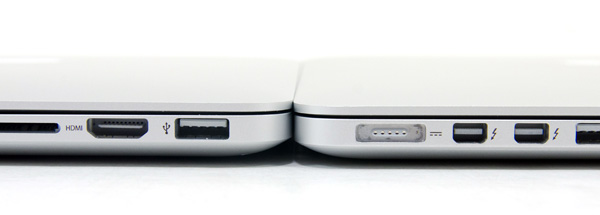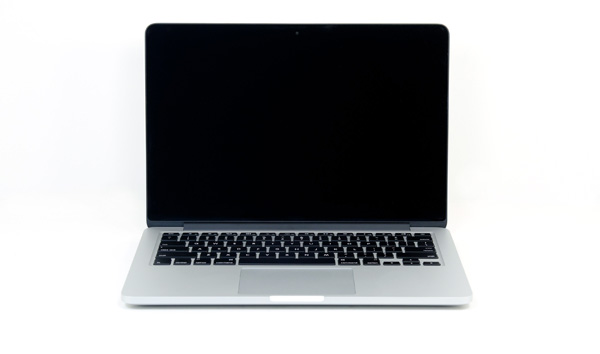13-inch Retina MacBook Pro Review (Late 2012)
by Anand Lal Shimpi on November 13, 2012 2:53 AM ESTFinal Words
When I reviewed it, I really liked the 15-inch Retina MacBook Pro. It's very fast, amazingly portable given its size and has a wonderful display. Its 13-inch counterpart, takes the portability to a completely different level. While I loved toting the 15 around (especially compared to its 2011 predecessor), it'd still feel like a burden after a long day of meetings. Using it in coach on most airlines was also problematic at times.
The 13-inch rMBP fixes the portability problem. Through a simple display switch, Apple's 13-inch MacBook Pro form factor went from uninteresting to perfect in my eyes. I do miss the larger display of the 15 from time to time, but the available scaled resolutions on the 13-inch rMBP make it a viable productivity machine. You don't sacrifice display quality at all in the move to the smaller panel. Brightness, contrast and color reproduction are all great. The MacBook Pro Retina Displays are easily the best Apple ships among all of its products.
Battery life is very good on the new machine thanks to its integrated 74Wh battery. Compared to a 15-inch rMBP, the 13-inch model delivers competitive battery life that is sometimes even better depending on whether or not the 15 has its dGPU active. Thermals and acoustics are also excellent thanks to the lower power components used inside.

13-inch rMBP (left) vs. 15-inch rMBP (right)
Then there are the givens: solid keyboard, trackpad, good WiFi, decent speakers and a well built chassis. The 13-inch rMBP retains all of these things.
You do give up performance in transitioning to the 13-inch Retina. You lose out on the quad-core CPU option and there's no room for a discrete GPU. If those matter to you, then you'll likely have to wait at least one more generation (maybe two) before Apple has a product that can satisfy all of your needs. I swapped out my 15-inch rMBP for the 13-inch model for the past couple of weeks in order to see if I'd really notice the performance difference. The lack of a dGPU wasn't terribly bothersome, but that's mostly because I didn't have time to play any games over the past couple of weeks. I definitely noticed the missing cores (and decrease in clock speed compared to the higher spec'd 15), although it wasn't something I couldn't get used to. Given how much I'm traveling lately, I'd almost say the loss of performance is worth it thanks to the weight and size reduction that you get with the 13. It's really a much easier notebook to travel with.
All of that being said, I don't really view the 13-inch rMBP as an alternative to the 15, but rather a step up from the MacBook Air. The MBA may be lighter, but Apple definitely blurred the line between the MBA and MBP with the 13-inch Retina. Performance is very similar between the two machines, but the rMBP's display is worlds better. For any power user, I don't know that I'd recommend the 13-inch MacBook Air over the 13-inch Retina MacBook Pro. It really is the best of both worlds.
Price is an obvious issue with all of the Retina MacBook Pro models. Apple did a great thing by outfitting all of the rMBPs with 8GB of memory, but the base $1699 configuration only comes with a 128GB SSD. Depending on your usage model, that may not be enough. Also if you're looking to minimize UI frame rate issues as much as possible you're going to want the upgraded CPU (although that still won't eliminate low UI frame rates). The problem is that upgrading both of these components together will set you back another $500 ($300 for the 256GB SSD and $200 for the faster CPU), putting the total system cost up at $2199. I would've liked to have seen a 256GB SSD in the base configuration at least. You do get a very good machine for the money, but it is a lot of money to spend.

13-inch rMBP (left) vs. 15-inch rMBP (right)
By far the biggest issue with buying the 13-inch MacBook Pro with Retina Display is that you know, in about a year, it'll be updated with even better hardware. It's very clear to me that the 13-inch rMBP was built with Haswell in mind. Without enough room for a discrete GPU, a CPU with significantly faster processor graphics (~2x in the case of Haswell) will open up the 13 to even more customers. Haswell should boast improvements in idle power, however since it's still built on Intel's 22nm process (like Ivy Bridge) it's not abundantly clear to me how active power will be impacted. Looking at the thermal data for the 13-inch rMBP alone leaves me comfortable saying there's some room to introduce more power hungry silicon without making the system unusable.
It rarely hurts to wait as there's almost always something better around the corner. If you are in the market for a Mac notebook however, the 13-inch MacBook Pro with Retina Display is a great option. It's not perfect. UI frame rates need help and the system is expensive, but it's easily the best balance of portability and productivity in Apple's lineup today.












79 Comments
View All Comments
Spunjji - Tuesday, November 13, 2012 - link
As of a few days ago Adobe updated Lightroom to include Retina support in the Develop window. That means the UI will scale while the image remains at a 1 for 1 pixel mapping and is unaffected by scaling.piroroadkill - Tuesday, November 13, 2012 - link
In your chart noting the different screen ratios, you have Retina MacBook Pro under 16:9 - clearly incorrect, 2560x1600 and 2880x1800 for the 13 and 15 inch respectively are 8:5 ratios (16:10 in common terms).Beerfloat - Tuesday, November 13, 2012 - link
A MacBook Pro needs a GPU, period. Sure, performance of the Intel solution is getting stronger, and may soon reach parity on the low end. But more importantly, the mature driver and ecosystem that Nvidia brings will still be an advantage for some generations to come.This kind of corner cutting is almost acceptable in the Air. But not in a Pro.
Spunjji - Tuesday, November 13, 2012 - link
Agreed. Shame, but definitely a compromise too far.mayankleoboy1 - Tuesday, November 13, 2012 - link
" I definitely noticed the missing cores (and decrease in clock speed compared to the higher spec'd 15),"What are you doing that makes use of 4 real cores ? And is the 200mhz speed difference really noticable ?
I would say that in normal surfing+office apps, a SSD would make all the differences between CPU redundant...
jramskov - Tuesday, November 13, 2012 - link
Lightroom would be one answer.mayankleoboy1 - Tuesday, November 13, 2012 - link
But does Anand even use it ? Regularly ?tipoo - Friday, December 7, 2012 - link
Why would someone buy this for "surfing+office apps"? It's meant to be a machine for professionals and high end users, hence Pro.smurray - Tuesday, November 13, 2012 - link
What app is being used to measure the FPS of the UI during things like Safari scrolling? I currently have an 13" rMBP w/ the upgraded i7 CPU and am curious what my results would be compared to what was experienced in the review.Ryan Smith - Tuesday, November 13, 2012 - link
For instantaneous tests like Safari (where you see the speedometer-styled FPS indicator), we use Quartz Debug. For average framerates over a period of time we use the GL Injection Tool.